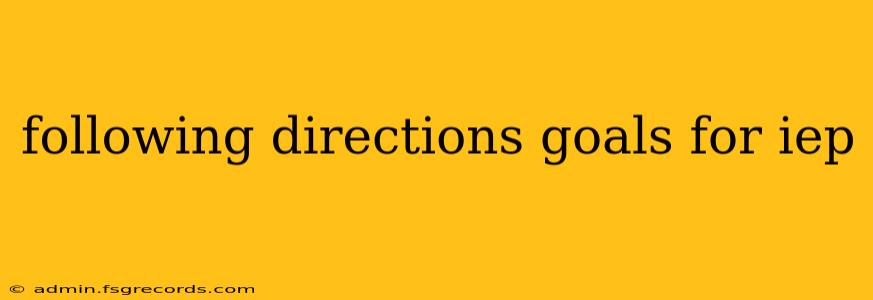Developing the ability to follow directions is crucial for success in school and life. For students with Individualized Education Programs (IEPs), specific, measurable, achievable, relevant, and time-bound (SMART) goals targeting this skill are essential. This post outlines strategies and examples for crafting effective goals for following directions within an IEP.
Understanding the Nuances of "Following Directions"
Before writing goals, it's important to define what "following directions" means for the student. This isn't a monolithic skill; it encompasses several sub-skills:
- Listening attentively: Comprehending verbal instructions.
- Remembering instructions: Retaining information over short and long periods.
- Interpreting instructions: Understanding the meaning and sequence of directions, including implicit instructions (e.g., implied steps).
- Executing instructions: Completing tasks accurately and in the correct order.
- Responding to feedback: Adjusting performance based on corrections or guidance.
- Self-monitoring: Checking one's own work to ensure accuracy.
- Organizing materials: Gathering and arranging necessary supplies before beginning a task.
Crafting SMART Goals for Following Directions in IEPs
When writing IEP goals related to following directions, consider these factors:
- Specificity: Avoid vague terms. Instead of "improve following directions," specify what directions the student will follow (e.g., one-step, two-step, multi-step, written, oral).
- Measurability: How will you track progress? Use quantifiable measures like percentage accuracy, number of steps completed correctly, or frequency of appropriate responses.
- Attainability: Goals should be challenging but achievable within the given timeframe. Start with smaller, more manageable steps before progressing to more complex tasks.
- Relevance: Goals must align with the student's current academic and functional needs. Consider the demands of the student's classroom and future goals.
- Time-bound: Set a clear timeframe for achieving the goal (e.g., by the end of the term, by the end of the year).
Example IEP Goals for Following Directions
Here are examples of SMART goals focusing on different aspects of following directions:
Goal 1: Following One-Step Oral Directions
- Student: [Student's Name]
- Goal: Given a single oral instruction in the classroom setting, [Student's Name] will accurately complete the task 80% of the time, as measured by teacher observation, across three consecutive observation periods.
- Conditions: The instructions will be clear, concise, and delivered at an appropriate pace.
- Criteria: Accuracy will be determined by whether the task is completed correctly and completely.
Goal 2: Following Two-Step Written Directions
- Student: [Student's Name]
- Goal: Given a two-step written instruction, [Student's Name] will accurately complete both steps in the correct sequence 90% of the time across four consecutive assignments.
- Conditions: The instructions will be presented in clear, simple language with visual supports as needed.
- Criteria: Accuracy will be determined by correct completion of both steps in the specified order.
Goal 3: Improving Self-Monitoring While Following Directions
- Student: [Student's Name]
- Goal: After completing a task involving multi-step directions, [Student's Name] will independently review their work and identify at least 2 out of 3 errors in their work 75% of the time, as measured by self-correction and teacher verification.
- Conditions: The tasks will be age-appropriate and relevant to the curriculum.
- Criteria: Self-correction and teacher verification will be used to determine accuracy.
Strategies for Success
These goals should be supported by evidence-based instructional strategies:
- Modeling: Demonstrate the task and clearly articulate the steps involved.
- Visual supports: Use visual schedules, checklists, or graphic organizers to aid comprehension.
- Chunking instructions: Break down complex directions into smaller, more manageable steps.
- Repetition and practice: Provide ample opportunities for practice and reinforcement.
- Positive reinforcement: Reward successful completion of tasks.
- Differentiated instruction: Adjust the complexity and support based on the student's individual needs.
By utilizing these strategies and crafting SMART goals, IEPs can effectively address students' challenges with following directions and promote their academic and life success. Remember to regularly monitor progress and adjust goals as needed to ensure the student is making optimal progress.

